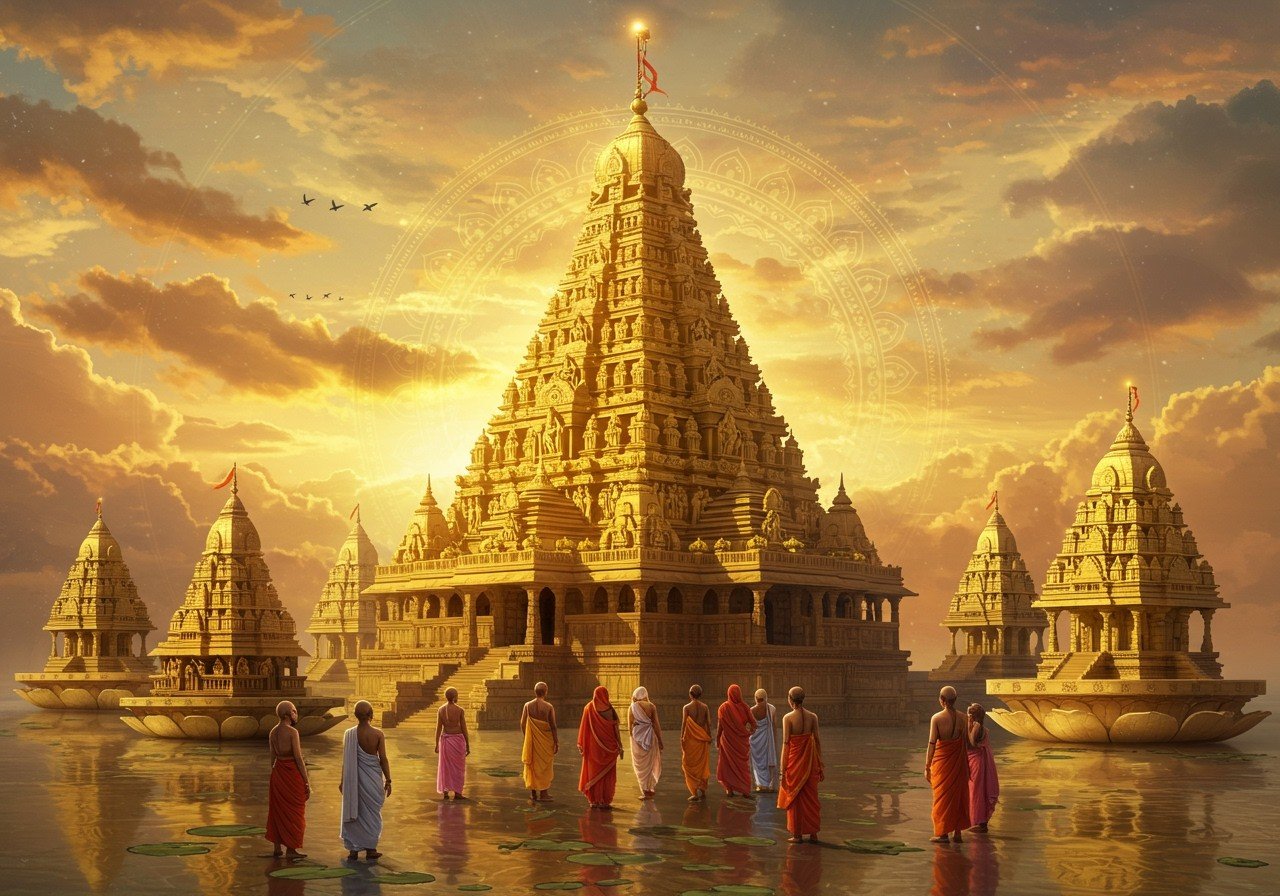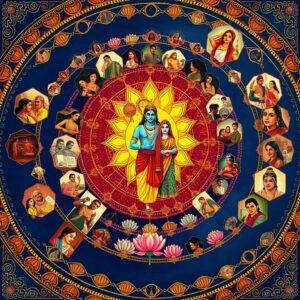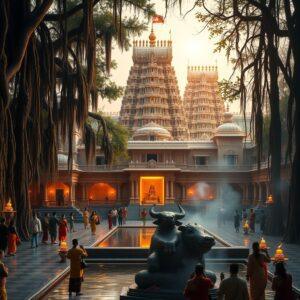
India is home to some of the most magnificent temples dedicated to Surya, the Sun God. These temples are not just architectural wonders but also hold immense historical and cultural importance. Surya plays a significant role in Hindu mythology, symbolizing light, energy, and knowledge. The worship of Surya has been an integral part of ancient Indian society, reflecting the widespread reverence for the Sun God across the subcontinent. For those interested in learning more about Hindu deities, Poojn.in offers a wealth of information and resources. Explore our collection of articles and blog posts on Lord Ganesha and Goddess Lakshmi to deepen your understanding of Hindu mythology.
The Konark Sun Temple
History and Architecture
The Konark Sun Temple, also known as the Black Pagoda, was constructed in the 13th century by King Narasimhadeva I of the Eastern Ganga dynasty. Its chariot shape, complete with twelve pairs of intricately carved stone wheels and seven horses, is a masterpiece.
- Intricate carvings: The temple walls are adorned with scenes from daily life, mythology, and the Kamasutra, showcasing the rich artistic traditions of the time. The level of detail in these carvings is truly breathtaking, offering a glimpse into the beliefs and practices of the era.
- Sunrise orientation: The temple is precisely designed to catch the first rays of the sunrise, a testament to the ingenuity of the ancient architects. This alignment highlights the importance of Surya as the source of light and life.
- UNESCO World Heritage Site: Recognized for its historical and architectural significance, the Konark Sun Temple stands as a testament to India’s rich cultural heritage. It is a must-visit destination for anyone interested in history, architecture, or spirituality.
Decline and Ruins
Natural disasters and invasions led to the temple’s decline. Despite being in partial ruins, it attracts many visitors. The annual Konark Dance Festival adds to its allure.
The Modhera Sun Temple
Architectural Grandeur
The Modhera Sun Temple in Gujarat was built in the early 11th century by King Bhima I of the Chaulukya dynasty. The temple’s layout includes:
- Main shrine (garbhagriha): This sacred space houses the deity and is the heart of the temple.
- Assembly hall (sabha mandap): A large pillared hall used for gatherings and religious ceremonies.
- Stepped tank (Surya Kund): A large, intricately carved stepped tank used for ritual bathing.
Unique Features
The Modhera Sun Temple is renowned for its unique features:
- Equinox alignment: The temple aligns with the equinox, allowing the first rays of the sun to illuminate the deity in the sanctum, a remarkable feat of astronomical and architectural precision.
- Exquisite carvings: Exquisite carvings on pillars and walls showcase various deities and scenes from Hindu epics, demonstrating the skill and artistry of the craftsmen.
The Martand Sun Temple
Historical Significance
The Martand Sun Temple in Jammu and Kashmir was constructed by King Lalitaditya Muktapida of the Karkota dynasty in the 8th century. It features a blend of Gandhara, Gupta, and Kashmiri architectural styles.
Layout and Preservation
- Central shrine and courtyard: The central shrine is surrounded by a colonnaded courtyard and subsidiary shrines, creating a spacious and awe-inspiring complex.
- Panoramic view: The temple’s location offers a panoramic view of the Kashmir Valley, adding to its beauty and serenity.
- Archaeological site: Currently an archaeological site due to destruction in the 15th century, the Martand Sun Temple remains a significant historical landmark.
The Suryanar Kovil
Dedicated to Surya
The Suryanar Kovil in Tamil Nadu, built by King Kulothunga Chola I in the 11th century, is part of the Nava Graha (Nine Planets) temples.
- Dravidian architecture: The temple showcases the Dravidian architectural style, featuring a five-tiered rajagopuram (gateway tower) and a sanctum housing Surya.
- Planetary deity shrines: A unique feature of the Suryanar Kovil is the inclusion of shrines for the other eight planetary deities within the temple complex.
- Ratha Saptami festival: The Ratha Saptami festival, celebrating Surya’s chariot journey, is a major event at the Suryanar Kovil.
The Katarmal Sun Temple
Lesser-Known Marvel
The Katarmal Sun Temple in Uttarakhand, built in the 9th century by King Katarmalla, features a pyramidal structure and intricate wooden carvings.
- Sunrise alignment: Like many Surya temples, the Katarmal Sun Temple is aligned with the sunrise, emphasizing the significance of solar worship. This alignment allows the first rays of the sun to enter the sanctum, illuminating the deity.
- Historical importance: The temple served as a center of learning and pilgrimage in the Kumaon region, playing a vital role in the religious and cultural life of the community.
- Preservation efforts: Ongoing work by the Archaeological Survey of India aims to preserve this architectural gem for future generations.
The Surya Pahar Temple
Ancient Site
The Surya Pahar Temple in Assam is an ancient site with numerous rock-cut sculptures and temples dedicated to Surya.
- Confluence of traditions: The Surya Pahar Temple uniquely represents a confluence of Hindu, Buddhist, and Jain traditions, showcasing the region’s diverse religious heritage. This blend of influences makes it a particularly fascinating site for scholars and visitors alike.
- Depiction of Surya: Surya is depicted riding a chariot, often accompanied by other deities, reflecting the iconography of solar worship in the region. These depictions offer valuable insights into the artistic and religious practices of the time.
- Archaeological significance: Excavations at the Surya Pahar Temple have revealed valuable information about its historical importance and the cultural practices of the people who built and worshipped there.
Poojn.in: Your Companion for Surya Puja
Enhance your spiritual journey and connection with Surya Dev with poojn.in. We offer a wide selection of authentic puja items and samagri to make your Surya puja complete. From incense sticks to sindoor, murtis, and more, poojn.in is your one-stop shop for all your puja needs. We also offer specially curated camphor and camphor tablets to enhance the sanctity of your worship space. Visit poojn.in today to explore our extensive collection.
Conclusion
The journey through India’s greatest Surya temples offers a glimpse into the country’s rich history, architectural brilliance, and deep-rooted cultural traditions. Each temple, from the majestic Konark Sun Temple to the serene Katarmal Sun Temple, tells a story of devotion, artistry, and the enduring significance of Surya in Hindu mythology. These temples are not just historical structures but living symbols of India’s spiritual heritage. They continue to inspire awe and reverence, drawing visitors from all over the world. Whether you seek a spiritual experience, a historical exploration, or an appreciation of architectural beauty, the Surya temples of India promise a fulfilling journey.
FAQs about India’s Greatest Surya Temples
What is the significance of Surya temples in India? Surya temples hold immense significance as they represent the ancient tradition of Sun worship, a source of life and energy in Hindu mythology.
What are some famous Suryanarayana temples in India? Notable temples include the Konark Sun Temple, Modhera Sun Temple, Martand Sun Temple, Suryanar Kovil, Katarmal Sun Temple, and Surya Pahar Temple. Each boasts unique architectural styles and historical significance.
What is unique about the Konark Sun Temple’s architecture? The Konark Sun Temple’s chariot-shaped design, with twelve intricately carved wheels and seven horses, is a marvel of ancient architecture, reflecting the Sun God’s celestial journey.
What festivals are celebrated at Surya temples? Ratha Saptami and Makar Sankranti are major festivals celebrated with fervor at Surya temples, honoring the Sun God and attracting numerous devotees.


